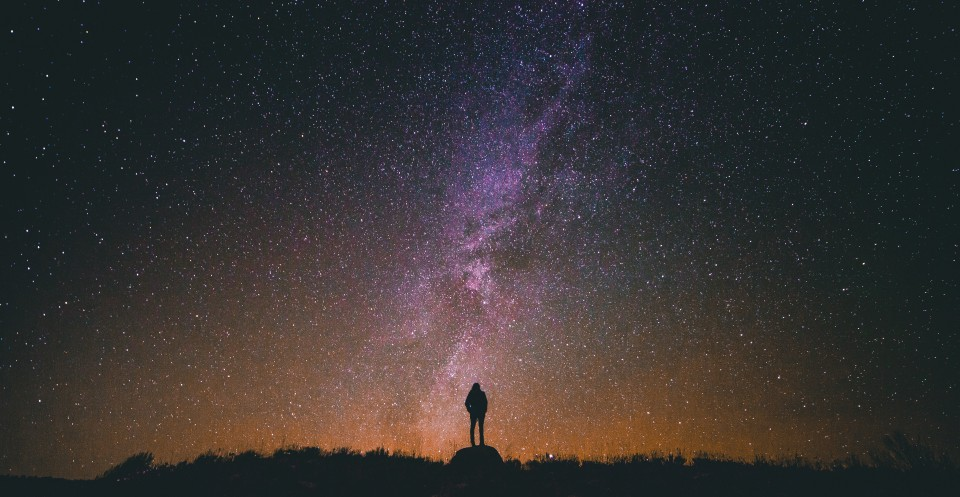If the Stars Were Made to Worship so Will I
By looking up at the sky on a clear night you can gain an appreciation for just how large God’s creation truly is. Choose any random star and the light you see ends its voyage anywhere between 4 and 13.3 billion years in your eye. If the stars (or planets orbiting them) could see the events taking place on earth, some would see the dinosaurs and some could even see Jesus teaching in Judea!
The stars are a beautiful analogy for God. Evidence of His hands abound as they dance tirelessly in seamless song. The mysterious and powerful hand of dark matter guiding the universe is analogous to the Holy Spirit. The sun, our source of light and warmth reminds us of Jesus, the Son. Without him, we simply wouldn’t exist. Faithfully circling around us is Mary, the unchanging face of the moon who is only visible due to the reflected light of the sun. Ven. Archbishop Fulton Sheen wrote: “[Mary] leads all souls to Christ and attracts only to ‘betray’ them to her Divine Son”. If you think about it, this is exactly what happens during a solar eclipse!! The new moon, which is hidden, sneaks up on the Sun and covers it up. When we look up to see why it’s suddenly dusky, we see the moon move away to reveal the sun before silently disappearing once more.
The solar eclipse in August wasn’t the only event happening in the sky recently with stunning symbolism.
In 3 or 2 BC, the Star of Bethlehem announcing Jesus’ birth was a rare triple conjunction of Jupiter (the king planet) and the king star, Regulus, in Leo (the lion and a symbol of the tribe of Judah) —forming, as Catholic columnist Patrick Archbold describes, “a giant neon sign in the heavens blinking KING-KING-KING.” Following Leo in the sequence of constellations through which the sun passes over the course of the year is Virgo--the virgin. At her feet, rising directly behind her, were the sun and the moon. After the conjunction, Jupiter began to move backwards in the sky (in retrograde motion) and came into conjunction with Venus, the planet associated with motherhood. As Archbold states: “the conjunction of the king planet and the motherhood planet was so close, that no man alive had ever seen anything like it and together it formed the brightest object in the sky.”
You’re probably saying: “Cool behavior, but what does that have to do with us now?” Glad you asked! Let’s visit Revelation 12: "A great sign appeared in the sky, a woman clothed with the sun, with the moon under her feet, and on her head a crown of twelve stars. She was with child...”
To paraphrase Archbold’s article, November 20th, 2016: Jupiter entered the body (womb) of Virgo and remained there thanks to its retrograde motion for the next 9 ½ months (coincidentally the length of the normal human gestation period) only to immerge (be born) on September 23rd, 2017. Due to the timing, as Virgo appeared over the horizon, the sun rose directly behind her (the woman clothed with the sun), the moon was stationed at her feet, and around her head was a crown of twelve stars—Leo’s nine plus the planets Mercury, Venus, and Mars.
What does this mean? Great question! Only God knows. Meanwhile, we can marvel at the symbolism and ponder God’s perfect timing since this occurred in conjunction with 100th anniversary of the apparitions of Our Lady of Fatima—the woman clothed in the sun—and when the sun miraculously danced.
God gave us the stars “‘to separate day from night…mark the fixed times, the days and the years and serve as luminaries in the dome of the sky, to shed light upon the earth.’” Looking at them is looking into the timeless; through them we can look into God’s fine details and incomprehensible imagination. Their beauty and complex-simplicity is breath-taking. The stars remind us that the darkest of nights is never truly dark since God is always with us: on moonlit nights Mary reigns and keeps watch over us. And on moonless nights there’s the river of light, the band of the Milky Way, which flows across the sky over the earth, pouring over us. The next time you gaze up at the stars, look for the hand that placed them.
Click here to see Archbold’s article for more details and further reading.
Teddy is a junior studying mechanical engineering at OSU and is in the Honors College. When Teddy isn’t studying you can find her doing research in a robotics lab on campus, star gazing on a clear night, reading a book from the Newman library, or riding her bike.

